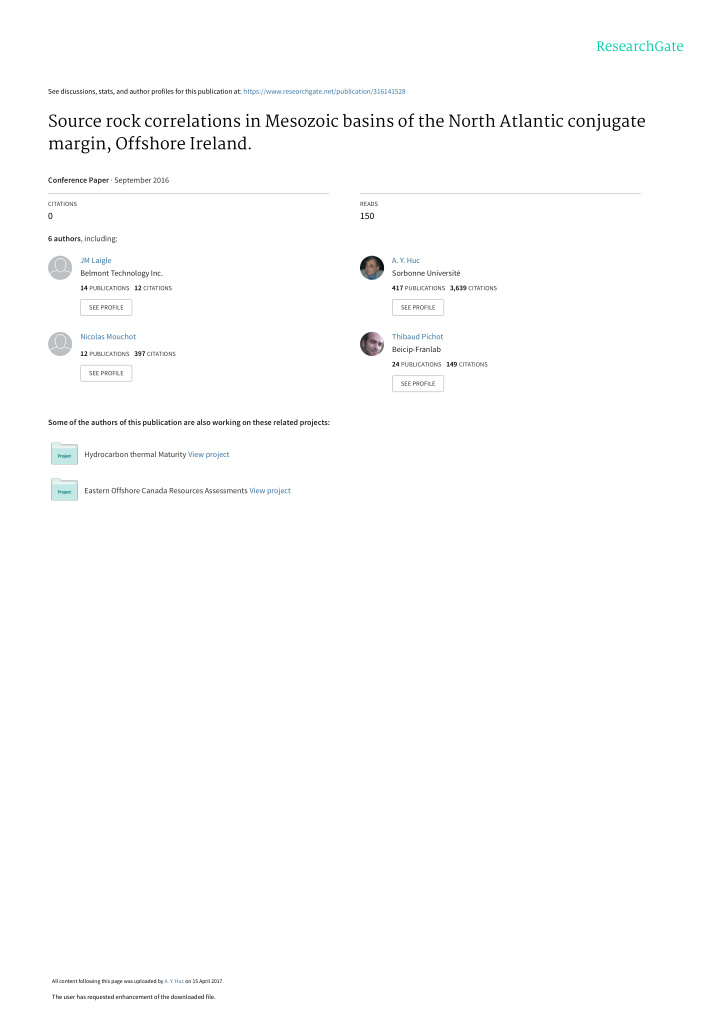



See discussions, stats, and author profiles for this publication at: https://www.researchgate.net/publication/316141528 Source rock correlations in Mesozoic basins of the North Atlantic conjugate margin, Offshore Ireland. Conference Paper · September 2016 CITATIONS READS 0 150 6 authors , including: JM Laigle A. Y. Huc Belmont Technology Inc. Sorbonne Université 14 PUBLICATIONS 12 CITATIONS 417 PUBLICATIONS 3,639 CITATIONS SEE PROFILE SEE PROFILE Nicolas Mouchot Thibaud Pichot Beicip-Franlab 12 PUBLICATIONS 397 CITATIONS 24 PUBLICATIONS 149 CITATIONS SEE PROFILE SEE PROFILE Some of the authors of this publication are also working on these related projects: Hydrocarbon thermal Maturity View project Eastern Offshore Canada Resources Assessments View project All content following this page was uploaded by A. Y. Huc on 15 April 2017. The user has requested enhancement of the downloaded file.
Source rock correlations in Mesozoic basins of the North Atlantic Conjugate Margin, Offshore Newfoundland and Offshore Ireland Laigle, J.M. 1 , Huc, A.Y. 1,2 , Piriou, S. 1 , Mouchot, N. 1 , Pichot, T. 1 Armstrong, J. 3 1) Beicip Franlab Email: Jean-Marie.Laigle@beicip.com ; 2) IsTep, UPMC – Université Pierre et Marie Curie – France ; 3) Consultant The North Atlantic Mesozoic basins are tectonically linked and share a common evolution related to the opening of the North Atlantic Ocean. In terms of oil and gas exploration, some basins have proved to be commercially successful (Jeanne d’Arc Basin, Celtic Sea) or are showing promising results (Flemish Pass), whereas others have experienced more limited success to date. To enhance present understanding and help define future exploration strategy, a review of the characteristics and distribution of source facies across North Atlantic basins of Ireland, Newfoundland and Labrador. To date, numerous geochemical well evaluations and integrated basin studies have been undertaken in these basins. This study was able to access such datasets from 620 offshore wells and additionally, from numerous scientific publications. These data were enhanced by further geological, geophysical and petrophysical studies. The primary objectives of this study were not only to produce a fully integrated database of already generated geochemical information in to which future data could be incorporated but also to use these data to produce an atlas of source rock and oil families across the study area. As a result of the initial review of the existing database well sections and oils that would benefit from further analyses were identified and a supplementary analytical programme was commissioned. This new programme includes a large set of Rock-Eval analysis distributed among 14 wells (from Celtic Sea, Fastnet Basin, Goban Spur, Porcupine, Orphan and Flemish Basins), biostratigraphical analyses, gas chromatography, GC-MS biomarker and carbon isotopes analyses on oil samples and rock extracts, as well as kerogen elemental analysis and kinetics determinations on key source samples of Carboniferous and Jurassic age. In addition to this phase of the study, a comparative assessment with analogue basins in Morocco, Iberia, Greenland, Faroe-Shetlands and. Nova Scotia has been made using the extensive of published data for these areas. Studied basins in the North Atlantic realm ATLANTIC IRELAND 2016 November 2016 Page 57 One new aspect of this study is the calculation of net source rock thickness and average present day TOC per interval. This has been achieved evaluations of well logs from 20 key wells on both margins. Leading on from this, in each of the study basins, source rock maturity history has been assessed using 1D and 2D basin modelling along re-interpreted seismic profiles. Organo-facies distribution and mapping of initial source potential (TOC0 and HI0 ) has been constrained by palaeo-geographical reconstructions. Studied basins in the North Atlantic realm ATLANTIC IRELAND 2016 November 2016 Page 57 One new aspect of this study is the calculation of net source rock thickness and average present day TOC per interval. This has been achieved evaluations of well logs from 20 key wells on both margins.
Leading on from this, in each of the study basins, source rock maturity history has been assessed using 1D and 2D basin modelling along re-interpreted seismic profiles. Organo-facies distribution and mapping of initial source potential (TOC0 and HI0 ) has been constrained by palaeo-geographical reconstructions. The present day maturity of source facies has been mapped regionally combining basin modelling and previously acquired data. Maturity, organo-facies and source potential maps have been combined to infer Present Day transformation ratio, generated and expelled hydrocarbon volumes and quality from key source rock horizons. This in-depth review has been constructed in a consistent tectono-stratigraphic framework to allow the drawing of important conclusions with respect to the forward exploration strategy in basins on both margins. Acknowledgements This project is funded by the Petroleum Infrastructure Programme (PIP) in Ireland and Nalcor Energy in Newfoundland-Labrador. Beicip wish to thank the staff of DCCAE/PAD, Nalcor Energy and the PIP Secretariat for their extensive support and input during this project. The help of James Armstrong who acted as Mentor for this project is gratefully acknowledged. We also thank the members of the project steering committee for their input and constructive discussions: Iain Scotchman (Statoil), Ranald Kelly (Woodside Energy), Ramzi Ghenima (Cairn Energy), Anne Marie Smith (Providence Resources). View publication stats View publication stats
Recommend
More recommend